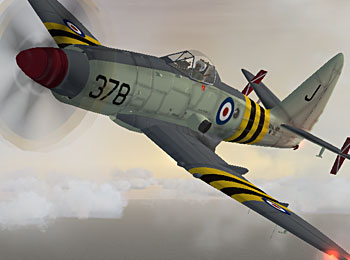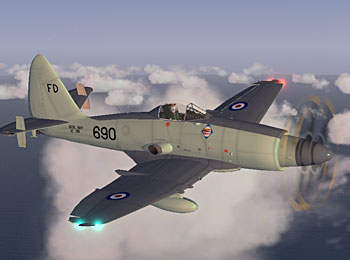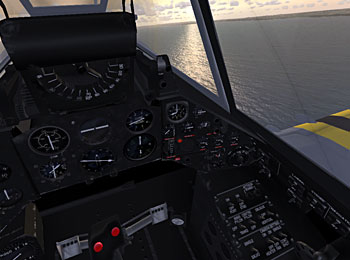
Credits:
Richard Ruscoe - The Flight ModelFraser Paterson - Graphics
Philip Chandler - Models
Ian Kirby - Alpha, Beta and possibly Gamma testing
Mark Barber - Beta Testing
Steve Beeny - Web Guru
*NEW* - Download the model for FSX *NEW* - Download Pilot's Notes
After a lengthy development that went through no less than 3 power plants, before finding one a manufacturer would produce in sufficient quantity, the Wyvern S.4 entered service in May 1953 with full squadron service starting in Ė54. The Wyvern is perhaps most famously remembered for its part in the 1956 Suez conflict which occurred halfway through its all too brief career.
The aircraft as modelled is in the later build state with a metal aft to the canopy, the original perspex proving insufficiently rigid, although providing a slightly better all round view. The radar warning aerials have been removed from the tail, the early equipment doing little more than alarming the pilot rather than providing an indication of a threat! Finally the wing-tip fold has been disabled, the greater hangar height of post war fleet carriers proving it unnecessary while most aircrew found it an annoyance, the tips being only a few inches above their heads when exiting the cockpit.
The flight model replicates the performance as described in the Pilot's Notes and from anecdotal accounts by service pilots. Performance of the 3,760hp Armstrong Siddeley Python allows her to reach 300kts on the deck, less than the claimed 340kts, but the most any service pilot actually saw. As in the original spool up at low power settings can take a few seconds, making carrier operations tricky again as in the original which suffered an appalling loss rate, including the world's first underwater ejection. Full operating details will be provided in the accompanying Virtual Pilot's Notes.
External stores are represented by tanks which appear automatically theyĖre filled from the fuel and payload panel in FSX. Additionally 1000lb bombs will appear under the wing and fuselage if the appropriate payload stations are loaded. ItĖs also possible to have them appear as droppable stores in a suitably modified saved flight. The aircraft has a fully functioning virtual cockpit with 3d animated gauges and switchgear, including a settable radar altimeter and retractable gun sight in accordance with the Pilot's Notes. For FSX Acceleration the Wyvern comes equipped with catapult attach points and tail hook to allow virtual carrier ops.



